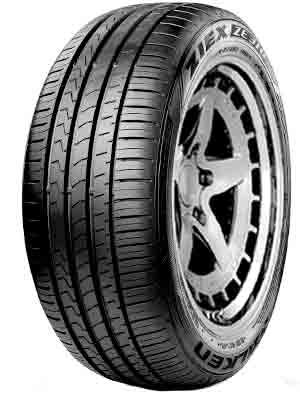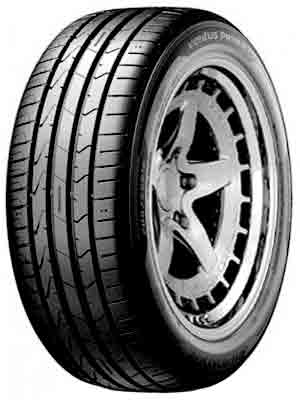Falken ZIEX ZE310 EcoRun vs Hankook Ventus Prime 3 K125: Both tires belong to the premium touring summer tire category that have generally wider tread to provide better grip and balanced handling capabilities in both dry and wet conditions during summer weather. EcoRun has a lower void ratio securing a good grip in all conditions and its broad shoulders provide reliable steering as well.
On the other hand, K125 has a higher void ratio which is beneficial for wet traction and its rolling resistance is lower, making it fuel-efficient.

Examine the treads on these tires closely. They hold the key to knowing which to choose. In fact if you visit my "tread design" page, picking the right tire would never bother you.
See below, how the four-pitch tread design of EcoRun performs against the five-pitch design of Prime 3.
Table of Contents
Comparing Falken ZE310 EcoRun with Hankook K125
Falken Ziex Ze310 EcoRun

Hankook Ventus Prime k125


Vs

EcoRun has an asymmetrical four-pitch tread design having three wide circumferential grooves which divides the tread into four columns. It has one rib and one tread blocks column. Its outboard shoulder has lateral grooves which don’t extend to its boundaries and its inboard shoulder has lateral grooves which open into the third circumferential groove. Sipes are present in between these lateral grooves on both shoulders. Its rib has inclined large sipes on the outboard end, while small sipes on the inboard end. Switchback design sipes on the blocks in the tread block column.
K125 has an aggressive five-pitch tread design with four wide circumferential grooves, thus, having five columns, two of which are shoulders while the rest are tread blocks columns. There is no rib available in this tire. Lateral grooves form the blocks on both the shoulders, but the outboard shoulder’s lateral grooves open into the first circumferential grooves while one in two lateral grooves of the inboard shoulder opens into the fourth circumferential groove. Inclined sipes are dividing the tread blocks in the central column while switch back sipes do the same in both the in and outboard intermediate tread blocks columns.
Grip Comparison
EcoRun has a higher contact patch which ensures a good grip. This contributes to the lower dry braking distance of this tire i.e., 113.2 feet. The efficient sipes available on the tread along with the higher contact patch allow it to stop readily on wet roads. This decreases this tire’s wet braking distance up to 123 feet, which is very impressive compared to other tire.
K125 has a lower contact patch providing a lesser surface of the tread to connect with the road. This reduces the grip and increases its dry braking distance. Therefore, this tire has a higher dry braking distance of 119 feet in comparison to its counterpart. Its wet braking distance is also higher due to its lower contact patch and inefficient sipes, resulting in a wet braking distance of 138 feet, much higher than its competitor.
Handling Comparison
The higher shoulder block length of EcoRun gives it an edge over its competitor in terms of dry handling. These broad shoulder blocks provide a better grip while turning through steep turns. It completes a lap over a dry circular track in 101.47 seconds. The presence of sipes on both the shoulders enhances its wet handling capability, decreasing its lap time around a wet circular track to 70.09 seconds.
On the other hand, K125 has a relatively lower length of its shoulder blocks which decreases the grip while steering. This results in a less capable tire in terms of dry handling. In wet conditions since only its outboard shoulder contains sipes, therefore it can’t provide good wet handling as well. Its lap timings are 102.05 and 72.28 seconds for dry and wet circular tracks respectively, both of which are higher than its counterpart, making this tire unreliable.
Comparison of Hydroplaning Resistance
The grooves of EcoRun are wider which allows it to efficiently pass the water through the tread. This allows this tire to achieve a higher float speed of 51.3 mph, making it an attractive option for driving on flooded roads.
Even though there are a greater number of circumferential grooves in the tread of K125, but they are narrow. Hence, these grooves are efficient in wiping away the water but they are not as good as Ecorun. Therefore, its float speed is 51.2 mph, which is decent but lower in comparison but barely.
Comparison of Rolling Resistance
The higher contact patch of the EcoRun increases its connection with the road which results in production of more friction. In order for the tire to roll, this friction must be overcome. This contributes largely to increasing this tire’s rolling resistance. It has a high rolling resistance value of 9.82Kg/t. Since a lot of force is needed to move the tire and this force is derived from fuel, therefore, the fuel efficiency of this tire is low.
The lower contact patch of K125 makes its rolling resistance lower because the friction produced between the tread and the road is lowered by the lesser portion of the tread connecting the road. This results in a lower rolling resistance of 8.98kg/t and since a lower amount of force is needed to move this tire, therefore, its fuel efficiency is higher.
Which tire is more comfortable?
The EcoRun has a lower noise level because it has a lower void ratio, allowing a lesser space for the entrapment of air particles. Since a lower amount of air particles gets trapped so they produce lesser noise by striking against the walls of the grooves. This makes this tire comfortable in terms of noise. While considering subjective comfort, this tire outperforms its competitor due to its better performance, resulting in a subjectively comfortable tire.
K125 has a higher void ratio, providing a large space for the entrapment of air particles that strike with the walls of the grooves to produce a loud noise. This decreases the comfortableness of this tire in terms of noise. Similarly, the lower performance of this tire doesn’t allow it to be subjectively comfortable as well.
Durability and Treadwear Differences
The higher rolling resistance of the tire causes higher treadwear. This along with softer rubber used in the tread of EcoRun decreases its durability. The lower durability contributes to the higher treadwear, causing this tire to be used only for a limited number of miles.
K125 has a lower rolling resistance causing lower treadwear. Harder rubber is used in the tread of this tire which increases its durability hence its treadwear resistance is higher. This enhances the mileage of this tire, making it much higher than its counterpart.
Price Differences
K125 is slightly lower priced than EcoRun due to its lesser performance while the higher price of EcoRun is justified by its better gripping and steering capabilities but at a cost of lower tread life. To choose one of these tires, you may want to decide according to your needs and preferences.
Quick Summary
- EcoRun and K125 are both premium touring summer tires.
- The dry and wet grip of EcoRun is better.
- EcoRun is also better equipped to steer well on sharp turns in all conditions.
- The float speed of EcoRun is higher proving its hydroplaning resistance capabilities.
- The rolling resistance of K125 is lower, making it highly fuel-efficient.
- EcoRun is quieter and also provides better subjective comfort.
- The durability and treadwear resistance of K125 is higher.
- K125 is a lowered-price tire.







